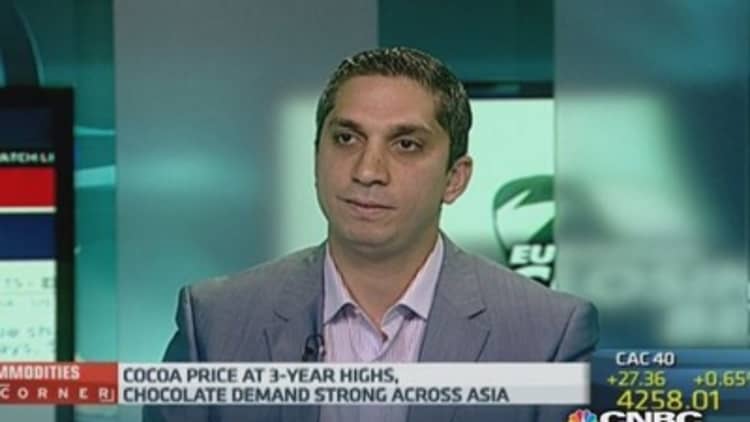
Asia's newly minted chocoholics are tempting sweets-makers seeking growth, but chocolatiers face fresh challenges ranging from different cultural tastes to the region driving cocoa prices to three-year highs.
"The chocolate consumption still is very low in Asia Pacific," Denis Convert, vice president for gourmet in Asia Pacific at Barry Callebaut, the world's largest chocolate maker, told CNBC last week.
"We are still at the beginning of the story. The average consumption is about 200 grams per capita in Asia Pacific when it is between 6-8 kilograms in Europe." But Asia's chocolate demand is growing about 10 percent a year, he said.
Globally, around $107.63 billion was spent on retail chocolate, with $13.06 billion of it in the Asia Pacific, according to data from Euromonitor.
Read More What soaring cocoa means for stocks, chocoholics
Courting that growth may be the main driver pushing to three-year highs. "The demand has outstripped supply for the third consecutive season. This hasn't been seen for 47 years," Erkut Ozer, CEO of Global Trading Enterprises, told CNBC recently. "The real demand factor has come from Asia. We've seen double-digit growth in chocolate consumption and that's really been the driver."
To counter the rising prices and still tap growing demand, Barry Callebaut is trying to boost its supply. "We work closely with the farmers to develop sustainable farming in order to improve the yields every year," Convert said, adding he expects the shortage to be a long-term issue for the industry.
Read More Nutella prices could surge. Here's why
Targeting farming methods isn't just about appearing environmentally friendly; it has a good chance of helping to boost supply. Ozer noted that much of the world's cocoa production is done on small family farms, with as much as 70 percent coming from Africa.
"The farms are very small. So efficiency-wise, they aren't the great producing farms that we expect from our other soft products," Ozer said. "We are starting to see a real shift in investment in that sector."
The cocoa supply isn't the only challenge in getting Asia hooked on chocolate. Many in the region find chocolate too sweet or "heaty," a reference to traditional Chinese medicine's belief that such foods can cause physical symptoms, such as sore throats.
Read More Mars, maker of M&M's, to raise prices 7%
For now, despite noting that some markets, such as Japan, actively seek less-sweet sweets, Barry Callebaut is primarily sticking with its global recipes, especially since much of the demand growth is in the premium segment, Convert said.

"Most of the consumption today is going into European-style cakes, where people accept that and are really curious to try this kind of experience," he said. But for more day-to-day consumption, "it's still a barrier to overcome, especially when we talk about chocolate drinks for example, [such as] hot chocolate."
Read More Attention chocoholics: Hershey to hike prices 8%
Asia also presents another challenge for chocolatiers in the region: the weather. In places such as India where the infrastructure isn't as developed, the humidity can affect product quality, Convert said.
Indeed, even in places with well-developed infrastructure, such as Singapore, the humidity can wreak havoc on sweets. Organizers of "Fantasia by Escriba," a chocolate-themed event in the tropical city state created by world-renowned pastry chef Christian Escriba, noted that shipping the giant chocolate and confectionary animals from Barcelona was a challenge.
Despite being shipped either by air or via climate-controlled containers, due to the humidity, several required extensive repair work once they arrived, Escriba said.
—By CNBC.Com's Leslie Shaffer; Follow her on Twitter @LeslieShaffer1

